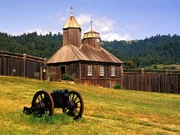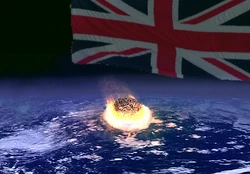Eureka (Ancient Greek) ("I have found it") | |||||||
| Anthem | "Grito de California" | ||||||
| Capital | Monterrey | ||||||
| Largest city | Los Ángeles | ||||||
| Other cities | Albuquerque, El Paso, Yerba Buena, Pitic, La Vega | ||||||
| Language official |
Spanish | ||||||
| others | French | ||||||
| Religion | Catholicism | ||||||
| Ethnic Groups main |
Hispanic | ||||||
| others | White (non-Hispanic), Black, Native American | ||||||
| Demonym | Californian | ||||||
| Government | Federal presidential constitutional republic | ||||||
| President | Susana Martinez | ||||||
| Population | 59.53 million | ||||||
| Established | 1850 | ||||||
| Independence | from Spain | ||||||
| declared | 1880s | ||||||
| recognized | 1890s | ||||||
| Currency | Californian peso ($) (CAP)
| ||||||
| Time Zone | (UTC-9) | ||||||
| Internet TLD | .ca | ||||||
| Organizations | North American Confederation, NATO | ||||||
The Republic of California, or simply California, is a sovereign state located in North America. It is bordered by Mexico to the south and Louisiana to the north and east.
Originally inhabited by native peoples such as the Chumash, the Utes, and the Navajo, the Spanish explored and began establishing missions in what is now California. The Russians established a trading post at Fort Ross in present-day Sonoma. Spanish settlements such as Los Ángeles, San Diego, and Santa Fe were established. The region was incorporated into the Viceroyalty of New Spain.
Thanks to the so-called "California Gold Rush," and with its new wealth and importance, California was split off from New Spain as a separate viceroyalty.
During the Spanish-American Wars of Independence in the 1880s, California gained independence. Since then California has remained relatively stable. California continued to grow in population and wealth, with people flocking to cities like Los Ángeles and Yerba Buena. Today, California is a developed country with a high standard of living, with membership in NATO and the North American Confederation.
Etymology[]
The name California is thought to have come from a fictional island kingdom, led by Queen Calafia. The name "Calafia" was chosen to resemble the word Caliph, implying that California was the Caliphate. Garci Rodríguez de Montalvo's 1510 novel Las Sergas de Esplandián is the origin of Queen Calafia and her land.
When Spanish explorer Francisco de Ulloa was charting the Baja California Peninsula, he had believed that the peninsula was an island, so he named the "island" California.
History[]
Pre-colonial era[]

Cliff Palace, one of the Ancestral Pueblo constructions at Mesa Verde.
California was originally inhabited by numerous Native American tribes. Notable tribes include the Chumash, Pueblo, Navajo, Utes, and Pima.
The Spanish began exploring the region in 1542 with an expedition led by Juan Rodríguez Cabrillo. Sebastián Vizcaíno explored and mapped the coast of California in 1602.
Spanish colonization and Fort Ross[]
The Spanish divided California into Alta California and Baja California, as provinces of New Spain. Baja California comprised of the Baja Peninsula, extending north to San Diego, where Alta California begins.
The first permanent mission in the California area was Misión de Nuestra Señora de Loreto Conchó, in present-day Loreto. However, after the

Fort Ross.
Portolá expedition, 21 more missions were established in Alta California along the Pacific Coast. Spanish soldiers also established presidios and pueblos; two of those pueblos would grow into Los Ángeles and San Jose.
In 1812, the Russian Empire established a trading post at Fort Ross in present-day Sonoma, north of San Francisco Bay. Operations at the fort continued until 1842, when it was sold to Johann Suter.
California Gold Rush and separate Viceroyalty[]
In 1848, gold was discovered at Suter's Mill, one of the properties of Johann Suter. Suter had tried to keep the word of gold from spreading, to no avail. Miners from all around the world began flocking to California in hopes of striking it rich. California saw a massive increase in growth during this time period, particularly in the boomtown of Yerba Buena.
Spain profited greatly from the "California Gold Rush." California now had grown significantly in both population, wealth, and importance. Spain made the decision to split off California from New Spain, as a separate Viceroyalty of California.
As a viceroyalty, California continued to see economic prosperity and growth. For the longest time, Yerba Buena remained the largest city in California. A railroad was constructed in the 1860s to connect Yerba Buena to San Diego, following the route of the old El Camino Real. This railroad went through the town of Los Ángeles, and the railroad itself would play a large role in the city's growth. The railroad connected Los Ángeles to Yerba Buena (and San Diego), and the arable land in the Los Ángeles Basin was perfect for agriculture. Industries continued to grow in the town, especially when oil was discovered in the vicinity. Los Ángeles had become a boomtown, and by the 1900s would become California's largest city.
Starting in this time period, California began seeing large numbers of Asian, particularly Chinese, immigrants. Chinese miners that came during the California Gold Rush settled in the cities, namely Yerba Buena. In later decades, some migrated to Los Ángeles seeking a career in agriculture or oil.
Independence[]
Government & Politics[]
Administrative divisions[]

California is a unitary state composed of five provinces.
Alta California (Yerba Buena)
Baja California (La Paz)
Sonora (Arizpe)
New Mexico (Santa Fe)
 Nevada (Pioche)
Nevada (Pioche)
| ||||||||||||||||||||||||
Government Orgnization[]
California is Federal presidential constitutional republic, and is one of the freest nations in the world. California has a working parliament, limited President, and strong judicial branch, that enforced the Californian constitution, and can legalize any impeachment of the president at will.




